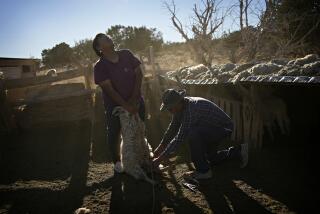Sheep Reduce Use of Herbicides in Forest
- Share via
GLENWOOD, Wash. — Some conservationists call sheep “desert maggots” for their destructive effect on rangeland. But the sheep grazing in the ponderosa and fir forest near here are as environmentally correct as recycled paper.
Forestry scientists monitoring the 2,200 animals foraging in the shadow of Mt. Adams say they are an old-fashioned alternative to chemical herbicides, since they chomp on underbrush that slows forest growth and sustains tree-killing gophers.
The sheep graze in timberlands owned by the state Department of Natural Resources and by Champion International Corp. The herd, owned by rancher Robert Shannon, are trucked to the range in May and hauled back to Shannon’s spread in Ellensburg in early fall.
No one involved in the nearly 3-year-old experiment pretends that sheep are a major alternative to herbicides or heavy equipment in the constant battle to remove brush and fight gophers, which kill young trees by eating their roots.
But, of any brush-control strategy in young industrial forests, plain old sheep can be the easiest on the land and should be used when possible, scientists say.
“This is environmentally sound. It doesn’t tear up the land, but it also works and that’s the best part,” said state Lands Commissioner Jennifer Belcher. “We’re looking at doing this in several areas.”
So is forest-products giant Champion International, which joined with the state to open a 2,000-acre summer range on adjoining state and Champion land in Klickitat County about 50 miles southwest of Yakima.
“We’re finding that in young forests, this approach gives us a golden opportunity to double the growth rate of trees in an environmentally sound way,” said Wayne Vinyard, forester and contract administrator for Champion’s Klickitat operation.
Properly applied, herbicides are environmentally sound and more cost-effective than sheep because they control brush much more quickly, Vinyard said. But given public antipathy toward herbicides, use of sheep can make the most political sense, he said.
Vinyard stopped to wipe his brow and survey the peaceful sight before him. Sheep, their bells clanking, churned up brown dust as they grazed their way up the hillside of young trees and headed for the shade of the forest above.
Shepherd John Garcia emerged from the dust behind the sheep, a rifle slung across his arm.
“It has been tough up here for the (sheep) owner,” Vinyard said. Two years before, a mountain lion killed nearly a dozen sheep, and there have been other losses to predators and rustling, he said.
Shannon, the rancher, pays no fees to graze his sheep, but that savings is offset by losses caused by the animals’ gaining weight more slowly, according to Louie Halloin, natural resources silvaculturist who oversees the grazing program for the state.
The herd’s weight gain is slowed because the grazing is tightly controlled to prevent overgrazing, he said.
Grazing restrictions include limits on how close sheep can get to riparian zones that buffer creeks and streams, he noted.
The late environmental writer Edward Abbey, among others, referred to sheep as “desert maggots” responsible for major overgrazing of Western rangelands.
Halloin, whose career has been devoted to creating environmentally sound forestry, said overgrazing is the fault of bad management, not the sheep.
“All parties in this operation work closely together to make it work,” he said. That means balancing the needs of the sheep with those of the environment.
“We think we’re doing that here,” Halloin said.
More to Read
Sign up for Essential California
The most important California stories and recommendations in your inbox every morning.
You may occasionally receive promotional content from the Los Angeles Times.













